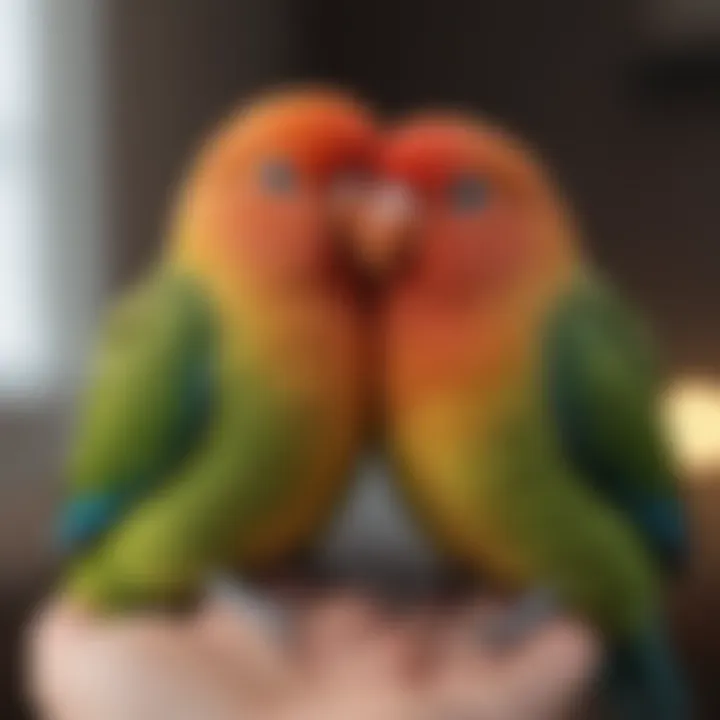Discovering Serene Pet Birds for Your Home


Intro
Birds can be some of the most intriguing pets one can own. While many people think of feathered companions as loud and boisterous, there’s another side to this avian world—a side that whispers rather than shouts. For those who seek serene companionship, understanding the quieter bird species can offer a glimpse into unparalleled tranquility. This section will unfold the essential aspects of caring for quieter pet birds, their behavioral insights, nutritional needs, and more. As we navigate through these facets, it’s crucial for potential bird parents and seasoned owners alike to recognize that choosing a peaceful avian companion can lead to a harmonious home.
Care Tips
When it comes to maintaining a peaceful environment for you and your pet, attention to daily care routines is imperative. Here's what to consider:
- Daily Care Routines: The foundation of bird care involves consistent feeding, fresh water supply, and social interaction. Quiet birds, like the Budgerigar, respond well to structured daily routines. Set specific times for feeding and interacting to establish a sense of security in your pet.
- Cage Setup and Maintenance: Choose a spacious cage that allows for movement. For smaller birds, cluttering the cage with toys can create a comfortable atmosphere without the constant need for vocalization. Use removable trays for easier cleaning.
- Hygiene and Cleaning Practices: Regular cleaning helps keep a peaceful environment. Remove waste daily and disinfect the cage weekly. A clean habitat contributes to your bird’s overall mood and health—less mess equals less stress.
- Seasonal Care Adjustments: As seasons change, so may your bird's needs. During colder months, ensure your pet is kept warm with adequate cage coverings. Hot weather requires shading, fans, and constant access to water.
Behavioral Insights
Understanding a bird’s behavior gives insight into their emotions and needs. Here are key areas to observe:
- Understanding Bird Body Language: Birds communicate a lot through body language. A relaxed bird with fluffed feathers and comfortable positioning shows contentment. Watch for tail movements; quick tail flicks can indicate excitement or fear.
- Common Behavioral Issues and Solutions: Quiet birds can still express unhappiness through different behaviors. One common issue is feather plucking, often linked to stress. Offering more social interaction or toys can alleviate this behavior.
- Positive Reinforcement Techniques: Reward training is beneficial. Use treats to reinforce good behaviors, such as stepping onto your finger or mimicking soft sounds. This reduces anxiety and improves your bond with your bird.
- Social Interaction Needs: While many quiet bird species are naturally more reserved, they still need interaction. Schedule daily quality time out of the cage for gentle play or just being nearby while you do everyday chores.
Nutrition Guides
Feeding your pet bird the right diet is essential for its health and tranquility. Consider the following:
- Essential Diet Components: A balanced diet typically includes high-quality pellets, fresh fruits, and vegetables. Seeds can be offered sparingly; many birds prefer varied textures.
- Safe and Toxic Foods: Always know what your bird can and cannot eat. Safe options include apples and carrots, but stay away from avocado and chocolate as they can be deadly.
- Supplements and Treats: Calcium nuts and cuttlebones can augment your bird’s diet, especially for egg-laying species. Treats like millet can be offered as a reward.
- Feeding Strategies for Different Species: Each type of bird may have specific feeding needs. For instance, Finches often enjoy a seed mix enriched with minerals, while Canaries generally thrive on a varied diet rich in greens.
Wellness and Health
Your bird’s wellness is closely tied to its living condition and care. To maintain optimal health:
- Routine Health Checkups: Regular veterinary visits are crucial, just as they are for cats and dogs. This catch any potential issues early.
- Identifying Symptoms of Illness: Signs like changes in appetite, droopiness, or unusual droppings often indicate health problems. Keeping a keen eye on your bird aids in early detection.
- Preventative Care and Vaccinations: Consult your vet about vaccinations. Some birds can benefit from routine preventatives against common ailments.
- Mental and Emotional Well-being: Like humans, birds experience stress. Ensure enrichment through songs, gentle voices, or calm environments to soothe your feathered friend.
Enriching Activities
Mental stimulation is key to keeping birds reasonably quiet and engaged.
- Toys and Playtime Ideas: Invest in non-toxic toys that encourage exploration and natural behaviors. Rotating toys frequently prevents boredom.
- Training and Tricks: Teaching light tricks can offer both stimulation and bonding opportunities. Simple actions like waving a wing or spinning are enjoyable for both bird and owner.
- Outdoor Activities and Interaction: If safe, explore outdoor environments in a flight harness. Natural sunlight and fresh air can uplift the mood of your pet bird.
- DIY Projects for Mental Stimulation: Create foraging toys from household items like paper rolls or cardboard boxes filled with treats. Such activities engage their natural instincts without contributing to noise.
Keeping a quiet bird doesn’t mean sacrificing the companionship that enriches our lives. It just takes a bit of awareness, care, and love to nurture the serenity they bring.
Prelude to the Quietest Pet Birds
In a world that often feels overwhelming with noise, finding peace in a pet can be quite the treasure. This is where quiet birds come into play, offering companionship without the cacophony. The topic of quieter pet birds is increasingly relevant as more people seek tranquil home environments. Understanding these avian companions not only broadens our appreciation of pet birds but also encourages responsible pet ownership.
Why focus on quiet birds? Well, it boils down to lifestyle compatibility. For folks living in small apartments or homes with thin walls, a loud parrot's call might disrupt the peace. So, looking into quieter alternatives becomes essential. Quiet birds can greatly enhance everyday living, especially for individuals who work from home or have young children.
Furthermore, quiet birds still possess charming personalities and vibrant colors. They provide emotional support without the incessant chatter that some species are known for. Their calm demeanor can create a soothing atmosphere, making them ideal companions for meditation and relaxation.
Considering factors like noise levels, living conditions, and the nurturing needs of these birds can ultimately dictate the success of a harmonious relationship between owner and pet. By exploring specific species known for their tranquility, this article aims to guide potential bird owners to make informed decisions regarding their avian companions.
In summary, diving into the world of quiet birds unveils not just their serene nature, but also their suitability for various lifestyles. As we proceed through this exploration, readers will gain valuable insights on characteristics, care requirements, and the social behaviors inherent in these gentle creatures. The journey of discovering quiet pet birds is also about embracing a quieter, more peaceful way of living.
Understanding Avian Noise Levels
Understanding avian noise levels is crucial for anyone considering a pet bird. Many potential owners forget that while birds can make delightful companions, they can also be noisy, disrupting the tranquility of a home environment. By grasping how different species communicate, one can better choose a bird that fits their lifestyle, ensuring that harmony prevails in the household.
Noise levels in birds vary widely depending on their species, age, and even individual personality. This variation significantly influences the owner’s experience. Knowing which birds are naturally quieter helps avoid potential stress for both the pet and its human companions. People might think they can handle a noisy bird, but if you’re used to silence, the squawking can quickly become overwhelming.
One key aspect to consider is how vocalizations are often a means for birds to communicate their needs, feelings, and social dynamics. Hence, understanding noise levels is intertwined with recognizing the nature of each species. This awareness can help foster a relationship built on understanding and patience, rather than frustration.
Defining Noise Levels in Birds
When we talk about noise levels in birds, we need to be clear about what that means. Birds produce sounds, from soft chirps to loud calls. For example, a parakeet may emit sounds ranging from gentle tweets to energetic squawks. In contrast, species like finches are generally much quieter, with their sounds being almost melodic and delicate. Measurement of these noise levels can be subjective; what one person finds soothing, another might consider a nuisance.
It’s essential to define noise levels not just by decibel count, but by how these sounds affect human comfort and daily activities. Quiet birds can often blend seamlessly into a relaxed environment, making them more suitable for individuals living in shared spaces or quieter neighborhoods.


Factors Influencing Bird Vocalization
Understanding why birds vocalize the way they do can be a game-changer in choosing the right pet bird. Various factors come into play regarding how and why birds make sounds, and they can be broken down into three main categories.
Species-Specific Behaviors
Birds have their own unique ways of expressing themselves. For instance, while cockatiels tend to be quite vocal, Bourke’s parakeets are known for their low-key nature. The key characteristic of species-specific behaviors is how they influence overall sound level.
For bird enthusiasts, choosing a species like a Bourke’s parakeet can be beneficial due to its calm demeanor. Unlike louder species, these birds rarely engage in excessive screeching. Their playful and soft vocalizations make them ideal companions for serene living spaces. However, it’s worth noting that even quieter species may have their moments, so understanding their inherent behaviors is essential.
Environmental Influences
The environment plays a significant role in how birds vocalize. A calm, well-structured home with minimal disturbances may encourage quieter behaviors. Conversely, a loud or chaotic environment can stress birds, prompting them to vocalize more. The key characteristic here is the connection between the bird's surroundings and its comfort level.
If you set up a cozy, clutter-free space for your avian friend, they may feel more at ease and less inclined to make noise. Environments enriched with appropriate toys and interaction opportunities contribute greatly to a bird’s tranquility. This unique feature can have a direct impact on noise levels, so it's important for owners to consider their home atmosphere.
Social Interactions
Birds are social creatures, and their interactions with humans or other pets significantly influence their vocalizations. A bird that feels lonely or neglected might be more prone to loud calls as a call for attention. This crucial aspect showcases the inherent need for companionship in birds.
The key characteristic of social interactions is how they foster emotional health. Positive engagement, such as regular handling or playtime, often leads to more subdued vocalizations. Owners should remember that while some birds can thrive in social environments, others may prefer solitude. Balancing their need for interaction with moments of quiet can bring harmony to their living conditions.
"Understanding avian noise levels is about more than just the sounds they make; it’s about creating a relationship based on trust and comfort."
By exploring these factors, potential bird owners can make informed choices about which species might fit seamlessly into their quiet homes. Knowing how species-specific behaviors, environmental influences, and social interactions shape vocalizations allows for a deeper understanding of what to expect from these beautiful companions.
Species that Are Naturally Quiet
In a world filled with bustling sounds and relentless noise, finding a companion that brings a sense of calm can be a breath of fresh air. This section explores species of birds renowned for their tranquil nature, shedding light on their characteristics and benefits as pets, especially for individuals seeking a peaceful environment.
Choosing a quiet pet bird can lead to an enriching and harmonious experience. These species not only provide companionship but also invite serenity into one's home. Before diving into specific birds, it's important to acknowledge that quiet birds often exhibit unique traits, making them particularly suitable for people who prioritize tranquility.
Bourke's Parakeet
Physical Characteristics
Bourke's Parakeets are charming little birds, averaging about 7 to 8 inches in length. Their soft and pastel colors—often shades of blue, pink, and yellow—lend them an aesthetically pleasing appearance. One of the standout features of Bourke's is their calm disposition, which is reflected in their gentle demeanor. They are not as boisterous as other parakeets, making them an ideal choice for quieter homes.
Moreover, their unique muted coloration allows them to blend well in a serene environment, complementing the peaceful aura often desired by avian enthusiasts.
Care Requirements
Caring for Bourke's Parakeets is straightforward, which contributes to their popularity among pet owners. These birds thrive in spacious cages filled with perches, toys, and ample room to fly and explore. Their diet primarily consists of high-quality seed mixes, fresh vegetables, and occasional treats. Regular social interaction is vital, as these birds are known for their friendly nature but also require a certain amount of independence to enrich their lives.
The simplicity of their care routine makes them a beneficial choice for those new to bird ownership, allowing individuals to focus on fostering a peaceful atmosphere without excessive complexity.
Behavioral Traits
Bourke's Parakeets are characterized by their mellow and sociable nature. Unlike many lively species, they prefer a more subdued environment and display affectionate behavior towards their owners. They are usually quite curious yet can also enjoy quiet moments, reflecting a balanced temperament. This ability to thrive in calm settings makes them particularly appealing for those seeking a serene feathered companion. Building trust is relatively straightforward, and these birds respond well to gentle interactions, ensuring a rewarding experience for both the bird and the owner.
Finches
Popular Finches for Beginners
Finches offer a delightful introduction to pet birds, especially varieties like the Zebra Finch and the Society Finch. Both are known for their relatively quiet nature, making them an excellent choice for first-time bird owners. Their colorful plumage and lively antics bring cheer without overpowering one's living space with noise.
Their small size and ease of care make them a fitting option for various households, including those with limited space.
Managing a few finches can certainly enhance the liveliness of life without crossing the threshold into chaos.
Social Behavior
Balancing their intrinsic sociability, finches thrive in pairs or small groups. They do not require constant interaction with humans, which allows their owners to appreciate their natural behaviors from a distance. Their gentle chirping and light social chatter contribute to a lively atmosphere without becoming disruptive. This lively yet tranquil demeanor encourages bird owners to appreciate them both as lively little creatures and calming companions, appealing to those who want pets without overwhelming sounds.
Habitat Needs
Creating a suitable living space for finches is essential for their well-being. They prefer spacious cages filled with various perches and enrichment activities to mimic their natural habitat.
Additionally, finches enjoy bathing opportunities. The inclusion of these elements ensures these birds not only feel secure but also fosters their natural behaviors. Thus, a well-designed habitat enhances their quiet nature, as it reduces stress and promotes a peaceful environment.
Canaries


Types of Canaries
Canaries come in numerous varieties, the most famous being the American Singer and the Yellow Canary. Each type has its unique coloration and singing ability, ranging from calm to more melodious tones. While they are known for their singing, many canaries exhibit delightful, soft sounds rather than loud calls, fitting into the quieter bird category.
This variety allows potential owners to find a specific type that aligns with their desire for a serene yet charming pet.
Calm Temperament
Generally, canaries have a gentle demeanor, often surprising newcomers with their friendly and calm disposition. They can be very responsive to their owners, yet they won't demand continuous attention. This quality is fantastic for those looking for a companion that doesn’t intrude upon their quiet moments. Their relaxing presence has been known to decrease stress, allowing for a peaceful coexistence that promotes mental well-being.
Care and Maintenance
Canaries require minimal grooming, apart from regular cage cleaning and a balanced diet free from processed foods. A fresh diet rich in seeds, vegetables, and occasional fruits maintains their health and contributes to a calm aura around them. Their care routine is fairly straightforward, often attracting individuals who may feel overwhelmed by more demanding pet birds. Thus, a canary can be an ideal choice, blending harmony with the responsibility of pet ownership.
Pionus Parrots
Unique Features
Pionus Parrots are lesser-known compared to their more boisterous relatives, yet their unique charm is hard to resist. They're slightly larger than parakeets, often ranging from 10 to 12 inches in length, with stunning plumage featuring shades of green with accents of blue, red, and maroon.
Their subtle beauty appeals to those seeking a less flamboyant pet bird in terms of both appearance and behavior. This uniqueness makes them an attractive option for discerning pet owners who want to showcase a quieter species.
Optimal Living Conditions
These parrots adapt well to various living situations. A spacious cage equipped with suitable toys and perches helps replicate their natural environment. They thrive in a calm space, which reflects their tranquil nature. Frequent interaction with their owners fosters strong bonds while allowing them moments of solitude to recharge. Nothing tops off their comfort like a bright corner of your living room or a similarly quiet spot in your home that invites relaxation and gentle companionship.
Training and Interaction
Pionus Parrots are relatively simple to train, often responding well to positive reinforcement techniques. Their calm nature makes training sessions enjoyable rather than stressful for both bird and owner. Moreover, they appreciate interaction but don't demand constant attention, striking a perfect balance that fits harmoniously into serene households. Their ability to engage in meaningful and relaxed playtime makes them a splendid companion for anyone wanting a peaceful pet experience.
Behavioral Considerations of Quiet Birds
When considering the companionship of birds that don't create a cacophony, understanding their behaviors is paramount. Quiet birds often exhibit distinctive social structures that reflect their calm demeanor. This aspect of avian behavior not only governs their interactions with their surroundings but also contributes significantly to the peaceful coexistence with their owners. By delving into the behaviors of these avian companions, owners can foster more enriching experiences, ensuring that both the bird and the human can flourish in a serene environment.
Social Structures in Quiet Species
In the avian world, social structures can greatly influence a bird's temperament and behavior. Quiet pet birds such as Bourke's Parakeets or finches tend to exhibit less aggressive social behavior compared to their vocal counterparts. These species often thrive in small, stable social groups, which contribute to their calm nature. Understanding these social structures enables potential bird owners to create environments that mimic their natural habitats, thus enhancing the mental well-being of the bird.
- A calm environment alleviates the stress that birds might face in a more chaotic, noisy atmosphere.
- Socialization opportunities, if provided appropriately, promote healthy interactions and reduce potential loneliness.
Calmness vs. Shyness
Quiet birds often present a mix between calmness and shyness. It's crucial to differentiate between these two traits for a better understanding of a bird’s needs and behaviors.
Identifying Calm Behaviors
Identifying calm behaviors in birds serves as a foundation for understanding their overall temperament. Calm birds may exhibit relaxed postures, gentle movements, and a preference for quiet activities, such as preening or resting. By recognizing these signals, bird owners can cater to their pets' needs effectively. For example, providing a quiet nook in the living space allows the bird to retreat and recharge.
- Key characteristic: Calm behaviors signify a bird's comfort within its environment.
- Advantage: Setting up the right space encourages more secure and happy birds.
Understanding Shy Birds
Shyness in birds often manifests as cautious behaviors, such as hiding or being less interactive. Recognizing these tendencies can help in tailoring approaches to care and interaction. Shy birds might take longer to adapt to new settings or owners, but with patience, they can reveal their unique personalities. This understanding emphasizes the importance of gentleness and gradual acclimatization in building relationships with these quiet companions.
- Unique feature: Shy birds exhibit behaviors that need time and space before they can engage fully with their surroundings.
- Disadvantage: Their timidity can sometimes be mistaken for disinterest or ill health.
Building Trust with Quiet Species
Establishing trust is fundamental when interacting with quiet birds. A trusting bond creates a secure environment where the bird feels comfortable engaging with humans. Simple practices, such as consistent feeding routines and gentle handling, can help foster this bond. Birds that trust their owners tend to be more emotionally stable and sociable.
- Key characteristic: Building trust is a gradual process, emphasizing reliability and predictability.
- Advantage: A trusting relationship results in better health and happiness for the pet bird, leading to a more fulfilling companionship.
In essence, understanding the behavioral dynamics of quiet birds is an essential element in ensuring their well-being. This knowledge equips bird owners with the ability to create a nurturing, calm environment conducive to the development of a lasting, amicable relationship with their avian companions.
Properly managing these behavioral considerations transforms the experience of avian companionship into one of tranquility and mutual respect.


Creating a Tranquil Environment for Quiet Birds
When it comes to keeping pet birds, creating a peaceful atmosphere is not just nice; it’s essential. Birds are incredibly sensitive creatures, and their well-being hinges not only on human interaction but also on the environment they inhabit. A tranquil setup supports the mental health of a quiet bird, enhancing its quality of life. Here’s how to set the stage for a serene living experience.
Cage Setup and Design
Size and Space Requirements
The size of your bird's cage holds more weight than one might think. A spacious cage not only gives birds room to stretch their wings—critical for physical health—but also promotes a sense of security. A larger setting allows for varied perches, toys, and hiding spots, making everyday life a whole lot richer. It’s often said that the bigger, the better in avian care.
Think about a cage size that not only matches the specific needs of your quiet bird but also fits your available space. For many smaller species, a cage that’s at least 24 inches wide provides enough surroundings while still being manageable in most homes.
Just remember, while a smaller cage may seem easy to maintain, it could lead to stress and frustration. It’s a balancing act, but when done right, spacious cages often reduce noise levels by allowing birds to express themselves in calmer, quieter ways.
Placement Considerations
Cage placement can make or break the tranquility of your bird’s environment. Positioning the cage in a well-lit room that avoids direct sunlight throughout the day can help maintain a comfortable atmosphere. Additionally, placing it in a corner can provide your feathered friend a sense of privacy—a critical factor in making them feel safe.
Choosing a quiet area, away from loud noises like TVs or busy traffic, contributes to a more serene living space. Birds often react to outside disturbances, and a calm space minimizes stress. Adequate placement should also consider social interactions. If your bird is too isolated, it may experience loneliness; on the flip side, too much hustle could scare it. Finding a middle ground is fundamental for their peace of mind.
Enrichment and Interaction
Enrichment is all about keeping your bird’s mind and body engaged. Incorporating interactive toys or varied structure in the cage—think swings, ladders, or climbing structures—can lead to happier birds that vocalize less out of boredom. This strategy helps to create an enjoyable environment where birds can explore and interact, reducing their need for loud calls for attention.
Key to success? Regularly rotate toys to keep things exciting. Birds are intelligent; they can get bored with repetitive stimulation. This scenario creates a natural home that’s not only pleasing for pets but for owners, too. When birds are happily engaged, they tend to express their happiness quietly, leading to a more harmonious home.
Minimizing Stress Factors
Minimizing stress factors is crucial in establishing a serene habitat for quiet birds. Stress can invite unnecessary vocalizations as birds try to express discomfort. Here are several strategies that can be effective:
- Routine: Birds thrive on predictability. Establish a regular feeding and interaction schedule.
- Quiet Hours: Designate quiet times in your home, especially during the night when they should be resting.
- Gradual Introductions: If you’re introducing new birds or pets, do so slowly to prevent overwhelming your feathery friends.
The goal is to recognize what stresses your particular bird. Being attentive and responsive to their needs will encourage a quieter, calmer presence. Ultimately, these carefully considered changes will lead to a bird that is not only less likely to vocalize excessively but also deeply content in its serene environment.
Selecting the Right Quiet Bird for Your Lifestyle
Choosing the perfect quiet bird for your home is not just about finding a gentle companion; it's about creating a harmonious relationship that enriches your life and the bird’s. Your lifestyle significantly impacts the selection process, influencing not only the bird's well-being but also your own enjoyment and satisfaction in sharing your daily life with these feathered friends. This section aims to outline essential considerations when selecting a quiet bird, ensuring that your choice aligns with both your living situation and personal commitment.
Assessing Personal Space and Commitment
When considering a quiet bird, taking stock of your personal space and the level of commitment required is fundamental. Birds may be peaceful relative to other pets, but they still need a structured environment and daily attention. Ask yourself:
- Space Availability: Do you have enough room for a birdcage that meets the species' needs? For example, a Bourke's Parakeet prefers a taller cage, while finches thrive in wider setups.
- Time Allocation: How much time can you genuinely dedicate to your pet each day? Quiet birds might enjoy interaction, but their needs for human connection can vary significantly.
- Activity Levels: You may lean towards birds known for calmer natures. Consider how active you are at home. For instance, Pionus Parrots are relatively quieter but still enjoy occasional playtime.
By carefully assessing these factors, you create a stable home for the bird while understanding that they thrive in environments that cater to their unique behaviors.
Evaluating Compatibility with Other Pets
Another crucial factor in the decision-making process is evaluating how your new avian friend will fit into your existing pet ecosystem. The dynamics between different species can be unpredictable, and it’s essential to anticipate these interactions. Here’s what to keep in mind:
- Species Interactions: Some birds coexist peacefully with other species, while others may feel threatened. For example, smaller finch species may adapt well in households with gentle cats, while larger parrots may see smaller animals as potential prey.
- Noise Tolerance: While you’re seeking a quieter bird, it's important to consider how other pets will react to avian sounds, even if they are minimal. Certain quiet species, like canaries, may still whistle occasionally, which can lead to unexpected reactions from dogs or other birds.
- Territory and Resources: Providing dedicated space is vital. If you have pets already, ensure the bird’s cage is placed where it feels secure, away from overly curious companions.
Evaluating these points fosters a peaceful coexistence in your household, allowing both you and your avian companion to live in sync with each other’s needs.
Engaging in this thoughtful process of selection will not only help you find the right quiet bird but also ensure a rewarding companionship that can greatly enhance your living environment.
End: Embracing the Calm of Quiet Birds
In a world that often favors the loud and vibrant, quiet birds offer a different sort of charm. Their tranquil nature is more than just a feature; it’s a way of life for many pet owners seeking peace in their homes. By selecting quieter avian companions, one can cultivate an environment that isn’t overwhelmed by the continuous chatter typical of many bird species. This choice can be especially significant in urban settings where noise can quickly become a source of stress.
Taking the time to understand the specific needs and traits of quiet birds, like Bourke's Parakeets, Finches, or Canaries, is vital. These birds not only bring beauty and serenity but also demand a gentle approach to care. By recognizing the delicate balance between a bird’s needs and your lifestyle, you can ensure a harmonious relationship that celebrates the subtleties of avian companionship.
Owning a quiet bird can also lead to deeper connections with these animals. They are known to observe and engage in ways that more vocal species might not. You may find that building trust with a quiet bird often leads to stronger bonds, as they communicate through body language and softer sounds. This quieter interaction can foster a unique companionship that is both fulfilling and calming.
"The quieter birds teach us that connection lies not just in noise, but in the gentle moments shared together."
Moreover, caring for quieter species may often involve fewer disruptions during daily routines. This becomes an invaluable aspect for people working from home or those with small children. Adapting the environment to cater to their needs not only benefits the bird but elevates the entire household’s atmosphere.
As you reflect on the points discussed throughout this article, consider the advantages of incorporating a quieter bird into your family. It's not merely about selecting a pet; it’s about creating a lifestyle steeped in tranquility. The beauty of avian companionship, especially amongst the quieter species, lies not only in their presence but in the peaceful environment they help nurture. Embrace this calm and enjoy the unique experiences these birds can bring into your life.















